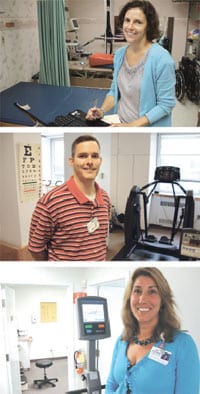Sweet Is Not So Sweet Diabetes Is on the Rise, and the Forecasts Are Troubling
More than 25.8 million children and adults have diabetes, according to the American Diabetes Assoc. And diabetes is one of the most common chronic diseases in children and adolescents, with about 151,000 people under the age of 20 years afflicted with the disease. Even more troubling, the Centers for Disease Control and Prevention projects cases to double, or even triple, before 2050.
In 1995, the diabetes rate in Massachusetts was 4.5{06cf2b9696b159f874511d23dbc893eb1ac83014175ed30550cfff22781411e5} compared to 7.5{06cf2b9696b159f874511d23dbc893eb1ac83014175ed30550cfff22781411e5} today. Also, over the past 15 years, we have seen diabetes rates double in 10 states. And there are no signs of the numbers slowing in children — at least, not while the number-one culprit in the rise of type 2 diabetes, childhood obesity, continues to grow among our nation’s youth.
There are two types of diabetes. Type 1, previously known as juvenile diabetes, is usually diagnosed in children and young adults. In type 1 diabetes, which strikes relatively quickly, the body does not make enough insulin, which is needed to convert blood sugar into energy for the cells of the body. Genetics and autoimmune problems play a major role in the development of type 1 diabetes, which requires insulin therapy. Type 2 diabetes, the most common form, which usually occurs as we grow older, is often associated with obesity. It develops when the body is resistant to insulin, requiring more insulin output combined with inability of the pancreas to keep up with this demand. Lifestyle changes, such as eating a healthy diet and exercising more, is enough for some to control blood-sugar levels, while others may need oral medication and/or insulin therapy.
Early symptoms of type 1 diabetes may not seem out of the ordinary or particularly troubling, such as increased thirst and hunger, fatigue, frequent urination, and weight loss, but failure to diagnose type 1 diabetes early can lead to serious illness. Symptoms for type 2 diabetes are similar, but typically occur more gradually and can include blurred vision, cuts and bruises that are slow to heal, and frequent infections.
Type 1 diabetes can be identified before any symptoms develop with an elevated glucose level in the urine or blood on well-child visits to the doctor, or become very advanced to the point of requiring admission to the hospital with lethargy, vomiting, unconsciousness, and other symptoms of diabetic ketoacidosis or very high blood sugars. Our goal as doctors is to diagnose as many children as possible with any nuances of type 1 diabetes before they exhibit any serious symptoms. We look to parents to identify symptoms as early as possible and make an appointment with their child’s pediatrician.
This is especially important because studies have shown that early detection and treatment can decrease the chance of developing complications of diabetes later in life, including heart disease, stroke, blindness, kidney damage, and limb amputations. Many also struggle with high blood pressure and high cholesterol.
One of the difficulties, sometimes, in identifying type 1 diabetes is that it can masquerade as other common childhood illnesses, such as gastroenteritis and anorexia nervosa. Also, many times parents dismiss the symptom of increased urine production, attributing it to the fact their child has been drinking more. As a result, parents often limit their child’s water intake, which can be dangerous and lead to dehydration.
When most children are diagnosed with diabetes, more often than not, it is assumed to be type 1. However, there has been a worldwide explosion over the past decades in the incidence of type 2 diabetes among young people. This has been attributed to a sedentary lifestyle devoid of exercise and too much time spent in front of the television or computer, combined with a diet rich in fast foods.
Because of this dramatic increase in type 2 diabetes, better physician awareness in its diagnosis will be necessary. It is sometimes difficult to decipher between type 1 and 2 in children, because kids who are heavy are assumed to have type 2 when it is actually type 1, and kids with type 2 can develop ketoacidosis, more often associated with type 1 diabetes.
Baystate Children’s Hospital provides a team approach to diabetes care. For type 1 diabetes, the team consists of a physician, nurse educator, nutritionist, and social worker. Children with type 2 diabetes are seen in a specialized clinic in conjunction with the weight-management team.
Helping to feed the epidemic of juvenile diabetes is a de-emphasis on physical education in the schools today, along with school lunch programs that are often high in fat and sugar. If kids aren’t learning to make exercise an important part of their lifestyle and learning to eat healthy, both at school and at home, then we are doing them a disservice in terms of their future health.
The good news for Massachusetts is that the report, “F as in Fat: How Obesity Threatens America’s Future,” recently released by the Trust for America’s Health and the Robert Wood Johnson Foundation, puts our state in good company with 20 others whose school meal standards are stricter than the U.S. Department of Agriculture. And, there’s more good news for Massachusetts. State health regulators in July unanimously approved new rules that ban sugary soft drinks and even diet sodas, along with unhealthy snacks, from public-school vending machines, snack shops, and a la carte cafeteria lines beginning in the 2012-13 school year.
And there is more good news. Despite the severe consequences of diabetes, especially for those who don’t properly manage the disease, insulin therapy and vigorous management can result in young children with type 1 diabetes going on to lead longer and healthier lives. And type 2 diabetes in youngsters can often be reversed with losing weight, following a healthy diet rich in fruits and vegetables, drinking plenty of water, and getting off the couch!
For more information about the services at Baystate Children’s Hospital, visitwww.baystatehealth.org/bch.
Dr. Holley Allen is chief of the Division of Pediatric Endocrinology at Baystate Children’s Hospital.



Comments are closed.